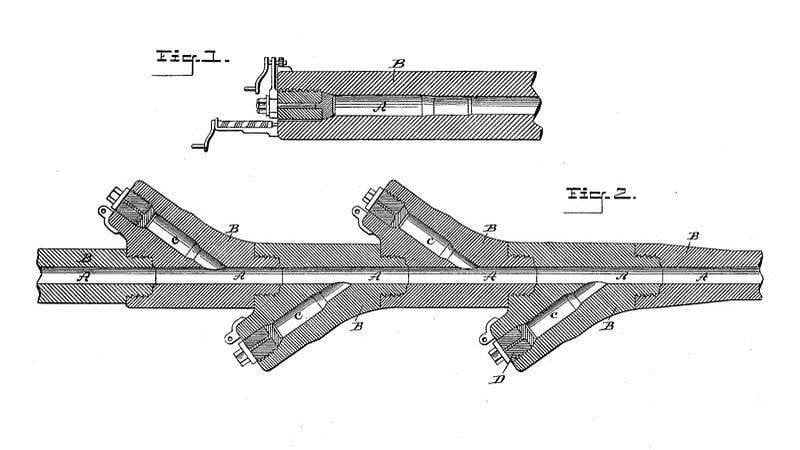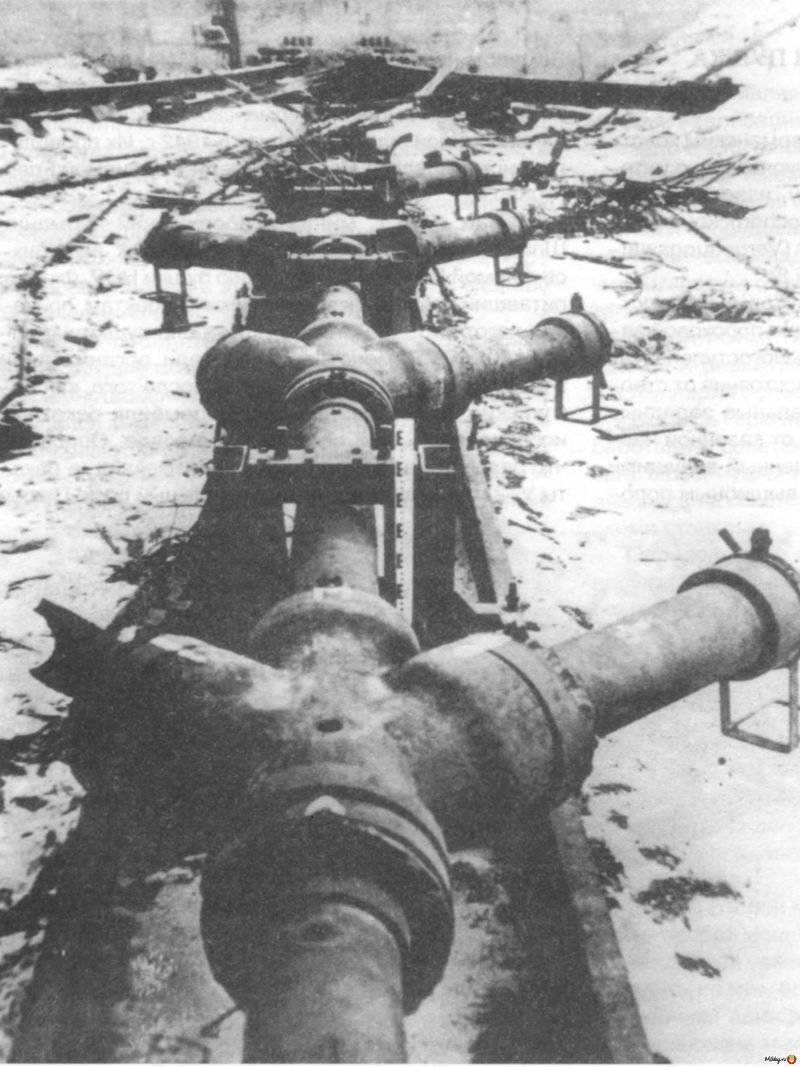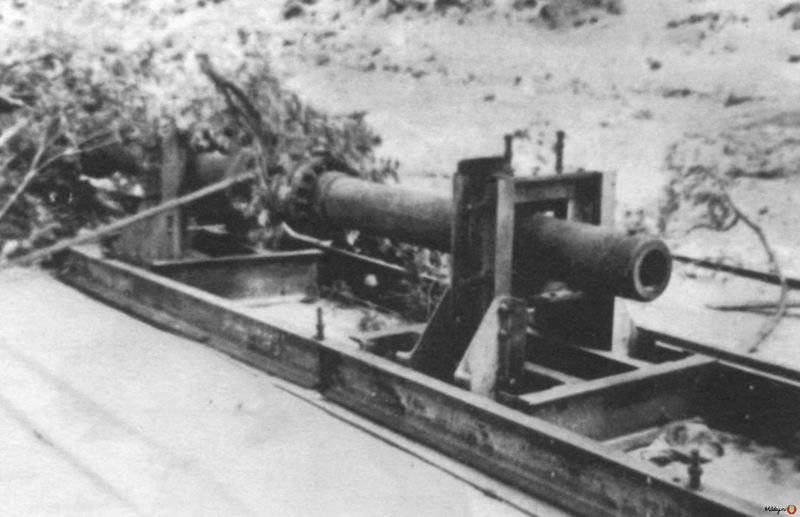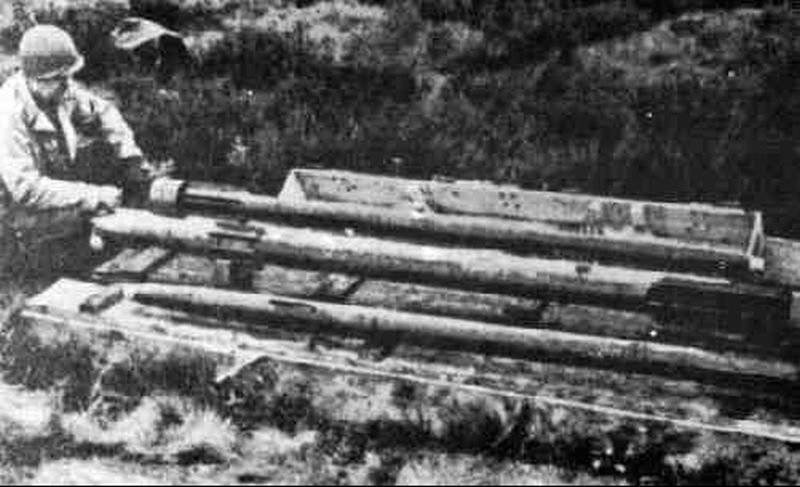Retaliation weapon sample No.3 - German long-range multi-chamber 150mm caliber "Hochdruckpumpe"

A. Hitler was not only a supporter of unconventional solutions and favored new ideas and projects, but also personally followed their development. Work on the German implementation of a multi-chamber instrument began in the 1942 year. At the same time, the head of the Ministry of Weapons reported on an unusual project to A. Hitler. He ordered to quickly create a real-life model with a smaller caliber, to demonstrate the capabilities of the new gun. Development and creation were carried out by Rochling together with Fried Kruapp AG. By September 1943, the current model was created - a multichannel gun caliber 20mm. The demonstration was carried out in a hurry - a little earlier, British aircraft caused serious damage to the German research rocket center in Peenemünde. After the demonstration and being afraid to develop weapons of retaliation, the V-2 missiles, A. Hitler ordered the developer, the company Rochling, to urgently manufacture 50 units of new HDP guns. The military construction organization OT-Zentrale was ordered to build two firing positions. They needed to be built on the coast of the Channel, so that the guns could fire on the capital of England - London.
The multichannel gun itself was a very interesting development, the abbreviated name “HDP” meant “high pressure pump”. In addition, the gun was classified as a “V-3” weapon (sample No. 3). The gun had a lot of nicknames and names, such as “English gun”, “Centipede”, “Hardworking Lizhen” and “Buddy”.

The main difference from the standard guns using a single charge for acceleration in the barrel, in a multichannel gun, the method of multi-stage acceleration of the shot was used. It consisted in the following: through the calculated-equal segments of a very long stem, additional chambers for placing the charges were made. They were performed at an obtuse angle to the muzzle of the barrel. The shot was laid in the breech of the gun and the initial movement was reported to him by a powder charge also laid in the breech. Next, a shot moving along the bore, explosions of charges in additional chambers, reported additional speed. The undermining of additional powder charges was carried out using electrics. As a result, the shot left the bore with a speed of at least 1500 m / s, which made it possible for the shot to reach distances in 160-170 kilometers. For an 150-caliber artillery shot, this was an unprecedented range.
Device and construction
The basis of the design was the trunk. It was a construction of 32 elements. Elements - parts of the trunk and additional chambers. All elements were assembled in a concrete shaft, the finished barrel was installed at an estimated elevation angle of 55 degrees. The trunk ended on the one hand with a breech, on the other hand with a muzzle. The total length of the gun was equal to 124 meters. The resulting design should weigh 62 tons, but due to the need to increase the reliability of the elements of the trunk, the total weight increased by 14 tons. The barrel had no rifling characteristic of modern guns.

An unusual projectile was developed especially for these guns - its length was slightly more than 3 meters, the weight of 140 a kilogram. 25 kilogram was assigned to the explosive charge. Although the caliber of the gun was 150mm, the designers carried out a projectile in a subcaliber version 110mm.
Due to the lack of rifling in the barrel, which in the conventional gun gives the shot the rotation necessary to stabilize the flight, flight stabilization was ensured by the tail feathering of the multi-channel gun. The plumage was supposed to open after exiting the barrel from the spring. There were other versions of sabot shells from 110 to 80mm. The weight of such shells ranged from 127 to 80 kilogram. They had a 4-6 folding stabilizer.
Difficulties "V-3"
Although the working model showed a satisfactory result, tests of the serial prototype in the early spring of 1944, passed with great difficulty. The developed shells did not acquire the required stabilization in flight. Although the tests, in principle, have shown that the instrument can be used for its intended purpose - according to remote real targets. The following difficulty arose from the problem of stabilization of the shot - the shells for the gun were already manufactured in large quantities, the shells which now had a structural flaw. At the time of the test has already been made more than 25 thousands of shells. The production capacity of shells was 10 thousands of shells per month. This number was not random, since the HDP gun firing rate was an 1 shot in 5 minutes. 50 guns for an hour could produce 600 shots. In 24 hours, they could make 14400 shots. According to the plans of A. Hitler, the guns were to fire round the clock the capital of England from a safe distance.

In this miscalculation, of course, the designers of the Rochling company were guilty, as it became known later that they had conducted an insufficient amount of aerodynamic studies of projectiles, which led to a structural error in the choice of the projectile stabilization plumage. Later, one more miscalculation became clear: when setting a fixed angle of elevation and direction, the ground rotation correction was not taken into account. But the developers and project managers were lucky that they didn’t have to report A. Hitler to the detected flaws of the gun, because in this case they were likely to be shot, British planes almost leveled the built firing positions for 50 guns. A little later, the location of the firing positions fell under the control of Canadian infantry.
There was another problem that was solved during the work - the insufficient initial velocity of the projectile and, as a consequence, the short range of destruction. The development involved six companies have long been developing and creating weapons and equipment for Germany. Soon they made the required projectile, fixed minor problems with the shutter.
Development of the HDP project
However, A. Hitler did not close the project of a promising long-range gun - he ordered the project to be reworked to allow them to be used in the field. The gun was built with a reduced barrel length of 50 meters. The barrel was also integral and consisted of 12 trunk elements, each with 2 chambers for charges and 13 inserts. The breech was used for 150mm sFH 18 howitzer. The total weight of the new gun was 28 tons. The gun gets the name "LRK15 F58". For shooting from a new gun, the projectile was modified, it became swept 150mm “Sprgr. 4481. The mass of the projectile was equal to 97 kilograms, the main charge weighed 5 kilogram, additional charges (24 units) had a total weight 72.8 kilogram. All charges reported the projectile total initial speed in 935 m / s, which gave him the opportunity to hit targets at a distance of 50 kilometers.
It was built four guns "LRK15 F58". They were installed near the city of Trier at an angle of elevation 34 degrees. The direction of shooting - the city of Luxembourg. Distance to the city - 42.5 kilometers. Calculation - 30 military. They were part of the 705 heavy artillery division. In the battles only two guns were used. The first combat use is 30.12.1944 of the year. Participated in battles with the United States 3 army. Only two guns were fired 157. At the end of the war, United States troops seized one of the guns and took it out to study on their territory.
The main characteristics of "V-3":
- caliber guns - 150mm;
- type of ammunition - subcaliber;
- ammunition caliber - 110mm;
- barrel length - 826 CLB (150м);
- total weight - 76 tons;
- ammunition weight - 140 kilogram;
- The initial speed of the ammunition - 1 500 m / s;
- range of destruction - 150-165 kilometers;
- elevation angle - fixed 55 degrees;
- the number of elements - 32 units;
- projectile length - 3.1 (2.5) meter.
Information sources:
http://waffen.jino.ru/index.php?option=com_content&view=article&id=799:-3-v-3-ltausendfussr-lr&catid=120:2011-12-28-07-43-41&Itemid=411
http://milday.ru/deutschland/deutschland-army/deutschland-artillery/1049-150-mm-sverhdalnoboynaya-pushka-hdp-v-3.html
http://www.wehrmacht-history.com/heer/heavy-artillery/15-cm-hochdruckpumpe.htm
Information